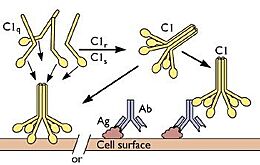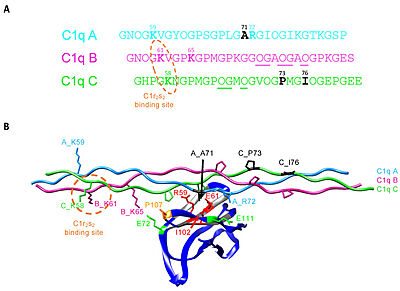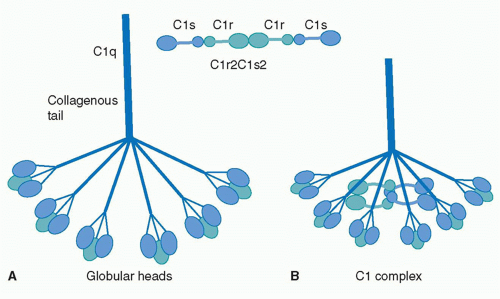User:Matthew Chien/Sandbox 1
From Proteopedia
(Difference between revisions)
| Line 27: | Line 27: | ||
== Disease == | == Disease == | ||
| - | A variety of diseases have been tied to an overabundance and lack of C1q in a person's body, most of which involve the presence of anti-C1q autoantibodies. Anti-C1q autoantibodies are antibodies that target one's own C1q, specifically the collagen-like tail of C1q. These are mistakenly generated through a misdirected immune response, and have the potential to develop into an autoimmune disease, although tests have shown that as much as 2-8% of healthy individuals still contain this antibody. Low levels of C1q and the presence of anti-C1q autoantibodies has been correlated with Hypocomplementemic Urticarial Vasculitis Syndrome (HUVS) or McDuffie syndrome. The main symptoms of this disease are chronic urticarial vasculitic lesions that persist more than 24 hours or are recurring. When these autoantibodies complex with C1q, they cause serum precipitins that contribute to swelling of the blood vessels. This can further lead to organ malfunction, various inflammatory diseases, arthritis, and a plethora of other diseases. <ref>PMID:23717311</ref><ref>PMID:22328958</ref><ref>PMID:29114186</ref> | + | A variety of diseases have been tied to an overabundance and lack of C1q in a person's body, most of which involve the presence of anti-C1q autoantibodies. Anti-C1q autoantibodies are antibodies that target one's own C1q, specifically the collagen-like tail of C1q. These are mistakenly generated through a misdirected immune response, and have the potential to develop into an autoimmune disease, although tests have shown that as much as 2-8% of healthy individuals still contain this antibody. Low levels of C1q and the presence of anti-C1q autoantibodies has been correlated with '''Hypocomplementemic Urticarial Vasculitis Syndrome''' (HUVS) or McDuffie syndrome. The main symptoms of this disease are chronic urticarial vasculitic lesions that persist more than 24 hours or are recurring. When these autoantibodies complex with C1q, they cause serum precipitins that contribute to swelling of the blood vessels. This can further lead to organ malfunction, various inflammatory diseases, arthritis, and a plethora of other diseases. <ref>PMID:23717311</ref><ref>PMID:22328958</ref><ref>PMID:29114186</ref> |
| - | Another disease associated with the presence of anti-C1q autoantibodies is Systemic Lupus Erythematosus (SLE), or just simply lupus. SLE is a disease where the body's own antibodies attack healthy tissue and cause inflammation. This disease, in the cause of SLE caused specifically by anti-C1q autoantibodies, is seen to cause Proliferative Lupus Nephritis (LN), a type of glomerulonephritis, which is inflammation and damage to the kidneys. This causes scarring of the tissue and malfunction of the blood vessels within the kidney and ultimately lead to kidney failure if not treated properly. Studies have been preformed that show that the presence of autoantibodies, including anti-C1q, in the kidneys is capable of producing limited disposition of the kidneys but not nephritis. Only when these anti-C1q autoantibodies are presented with C1q-containing immune complexes do they cause LN. It is unknown why anti-C1q autoantibodies predominantly enhance tissue damage in the kidneys and not in other tissues known to contain C1q immune complexes. <ref>PMID:27252264</ref> | + | Another disease associated with the presence of anti-C1q autoantibodies is '''Systemic Lupus Erythematosus''' (SLE), or just simply lupus. SLE is a disease where the body's own antibodies attack healthy tissue and cause inflammation. This disease, in the cause of SLE caused specifically by anti-C1q autoantibodies, is seen to cause '''Proliferative Lupus Nephritis''' (LN), a type of glomerulonephritis, which is inflammation and damage to the kidneys. This causes scarring of the tissue and malfunction of the blood vessels within the kidney and ultimately lead to kidney failure if not treated properly. Studies have been preformed that show that the presence of autoantibodies, including anti-C1q, in the kidneys is capable of producing limited disposition of the kidneys but not nephritis. Only when these anti-C1q autoantibodies are presented with C1q-containing immune complexes do they cause LN. It is unknown why anti-C1q autoantibodies predominantly enhance tissue damage in the kidneys and not in other tissues known to contain C1q immune complexes. <ref>PMID:27252264</ref> |
An overabundance of C1q has shown to correlate with the development of neurodegenerative diseases and loss of cognitive function. Higher age groups are seen to have larger levels of C1q, especially in their brain. This buildup mainly occurs because of poorer activity in synaptic clearing of C1q bound to neuronal RNA-binding proteins called neuronal ribonucleoprotein complexes, affecting protein homeostasis in the brain and decreasing cognitive function. C1q is involved in pruning synapses in developing brains by tagging the synapses for phagocytosis by microglia. Elevated concentrations of C1q in the synapses has been correlated with overactivity of microglia when provoked by brain injury or a series of strokes. Most cells in the body have complement inhibiting agents to regulate complement activity, whereas nerve cells lack these complement inhibitors. Astrocytes are known to secrete C1q when provoked by infections or damage to the central nervous system, and an overproduction of these can lead to over inflammation in the brain by the complement cascade and synapses loss, both fundamental components of Alzheimer's disease and various other neurodegenerative diseases. <ref>PMID:23946404</ref><ref>PMID:38942014</ref><ref>PMID:37033981</ref> | An overabundance of C1q has shown to correlate with the development of neurodegenerative diseases and loss of cognitive function. Higher age groups are seen to have larger levels of C1q, especially in their brain. This buildup mainly occurs because of poorer activity in synaptic clearing of C1q bound to neuronal RNA-binding proteins called neuronal ribonucleoprotein complexes, affecting protein homeostasis in the brain and decreasing cognitive function. C1q is involved in pruning synapses in developing brains by tagging the synapses for phagocytosis by microglia. Elevated concentrations of C1q in the synapses has been correlated with overactivity of microglia when provoked by brain injury or a series of strokes. Most cells in the body have complement inhibiting agents to regulate complement activity, whereas nerve cells lack these complement inhibitors. Astrocytes are known to secrete C1q when provoked by infections or damage to the central nervous system, and an overproduction of these can lead to over inflammation in the brain by the complement cascade and synapses loss, both fundamental components of Alzheimer's disease and various other neurodegenerative diseases. <ref>PMID:23946404</ref><ref>PMID:38942014</ref><ref>PMID:37033981</ref> | ||
Revision as of 13:13, 29 April 2025
| |||||||||||
References
- ↑ Reid KBM. Complement Component C1q: Historical Perspective of a Functionally Versatile, and Structurally Unusual, Serum Protein. Front Immunol. 2018 Apr 10;9:764. PMID:29692784 doi:10.3389/fimmu.2018.00764
- ↑ Janeway CA Jr, Travers P, Walport M, et al. Immunobiology: The Immune System in Health and Disease. 5th edition. New York: Garland Science; 2001. The complement system and innate immunity. Available from: https://www.ncbi.nlm.nih.gov/books/NBK27100/
- ↑ Kishore U, Ghai R, Greenhough TJ, Shrive AK, Bonifati DM, Gadjeva MG, Waters P, Kojouharova MS, Chakraborty T, Agrawal A. Structural and functional anatomy of the globular domain of complement protein C1q. Immunol Lett. 2004 Sep;95(2):113-28. PMID:15388251 doi:10.1016/j.imlet.2004.06.015
- ↑ Kaul M, Loos M. Dissection of C1q capability of interacting with IgG. Time-dependent formation of a tight and only partly reversible association. J Biol Chem. 1997 Dec 26;272(52):33234-44. PMID:9407113 doi:10.1074/jbc.272.52.33234
- ↑ Mortensen SA, Sander B, Jensen RK, Pedersen JS, Golas MM, Jensenius JC, Hansen AG, Thiel S, Andersen GR. Structure and activation of C1, the complex initiating the classical pathway of the complement cascade. Proc Natl Acad Sci U S A. 2017 Jan 31;114(5):986-991. PMID:28104818 doi:10.1073/pnas.1616998114
- ↑ Sontheimer RD, Racila E, Racila DM. C1q: its functions within the innate and adaptive immune responses and its role in lupus autoimmunity. J Invest Dermatol. 2005 Jul;125(1):14-23. PMID:15982298 doi:10.1111/j.0022-202X.2005.23673.x
- ↑ Dunkelberger JR, Song WC. Complement and its role in innate and adaptive immune responses. Cell Res. 2010 Jan;20(1):34-50. PMID:20010915 doi:10.1038/cr.2009.139
- ↑ Marqués G, Antón LC, Barrio E, Sánchez A, Ruiz S, Gavilanes F, Vivanco F. Arginine residues of the globular regions of human C1q involved in the interaction with immunoglobulin G. J Biol Chem. 1993 May 15;268(14):10393-402 PMID:8486696
- ↑ Duncan AR, Winter G. The binding site for C1q on IgG. Nature. 1988 Apr 21;332(6166):738-40. PMID:3258649 doi:10.1038/332738a0
- ↑ Almitairi JOM, Venkatraman Girija U, Furze CM, Simpson-Gray X, Badakshi F, Marshall JE, Schwaeble WJ, Mitchell DA, Moody PCE, Wallis R. Structure of the C1r-C1s interaction of the C1 complex of complement activation. Proc Natl Acad Sci U S A. 2018 Jan 8. pii: 1718709115. doi:, 10.1073/pnas.1718709115. PMID:29311313 doi:http://dx.doi.org/10.1073/pnas.1718709115
- ↑ Venkatraman Girija U, Gingras AR, Marshall JE, Panchal R, Sheikh MA, Gal P, Schwaeble WJ, Mitchell DA, Moody PC, Wallis R. Structural basis of the C1q/C1s interaction and its central role in assembly of the C1 complex of complement activation. Proc Natl Acad Sci U S A. 2013 Aug 20;110(34):13916-20. doi:, 10.1073/pnas.1311113110. Epub 2013 Aug 6. PMID:23922389 doi:10.1073/pnas.1311113110
- ↑ Guan EN, Burgess WH, Robinson SL, Goodman EB, McTigue KJ, Tenner AJ. Phagocytic cell molecules that bind the collagen-like region of C1q. Involvement in the C1q-mediated enhancement of phagocytosis. J Biol Chem. 1991 Oct 25;266(30):20345-55 PMID:1939090
- ↑ Fouët G, Bally I, Chouquet A, Reiser JB, Thielens NM, Gaboriaud C, Rossi V. Molecular Basis of Complement C1q Collagen-Like Region Interaction with the Immunoglobulin-Like Receptor LAIR-1. Int J Mol Sci. 2021 May 12;22(10):5125. PMID:34066122 doi:10.3390/ijms22105125
- ↑ Mahler M, van Schaarenburg RA, Trouw LA. Anti-C1q autoantibodies, novel tests, and clinical consequences. Front Immunol. 2013 May 14;4:117. PMID:23717311 doi:10.3389/fimmu.2013.00117
- ↑ Buck A, Christensen J, McCarty M. Hypocomplementemic urticarial vasculitis syndrome: a case report and literature review. J Clin Aesthet Dermatol. 2012 Jan;5(1):36-46 PMID:22328958
- ↑ Jayakanthan K, Gupta AN, Mathew J, Ravindran R, Mahasampth G, Danda D. Clinical utility of anti-C1q antibody in primary and secondary vasculitic conditions. Int J Health Sci (Qassim). 2017 Nov-Dec;11(5):3-6 PMID:29114186
- ↑ Stojan G, Petri M. Anti-C1q in systemic lupus erythematosus. Lupus. 2016 Jul;25(8):873-7. PMID:27252264 doi:10.1177/0961203316645205
- ↑ Stephan AH, Madison DV, Mateos JM, Fraser DA, Lovelett EA, Coutellier L, Kim L, Tsai HH, Huang EJ, Rowitch DH, Berns DS, Tenner AJ, Shamloo M, Barres BA. A dramatic increase of C1q protein in the CNS during normal aging. J Neurosci. 2013 Aug 14;33(33):13460-74. PMID:23946404 doi:10.1523/JNEUROSCI.1333-13.2013
- ↑ Scott-Hewitt N, Mahoney M, Huang Y, Korte N, Yvanka de Soysa T, Wilton DK, Knorr E, Mastro K, Chang A, Zhang A, Melville D, Schenone M, Hartigan C, Stevens B. Microglial-derived C1q integrates into neuronal ribonucleoprotein complexes and impacts protein homeostasis in the aging brain. Cell. 2024 Aug 8;187(16):4193-4212.e24. PMID:38942014 doi:10.1016/j.cell.2024.05.058
- ↑ Zhang W, Chen Y, Pei H. C1q and central nervous system disorders. Front Immunol. 2023 Mar 23;14:1145649. PMID:37033981 doi:10.3389/fimmu.2023.1145649
- ↑ Bally I, Ancelet S, Moriscot C, Gonnet F, Mantovani A, Daniel R, Schoehn G, Arlaud GJ, Thielens NM. Expression of recombinant human complement C1q allows identification of the C1r/C1s-binding sites. Proc Natl Acad Sci U S A. 2013 May 21;110(21):8650-5. PMID:23650384 doi:10.1073/pnas.1304894110
- ↑ Roumenina LT, Kantardjiev AA, Atanasov BP, Waters P, Gadjeva M, Reid KB, Mantovani A, Kishore U, Kojouharova MS. Role of Ca2+ in the electrostatic stability and the functional activity of the globular domain of human C1q. Biochemistry. 2005 Nov 1;44(43):14097-109. PMID:16245926 doi:10.1021/bi051186n




